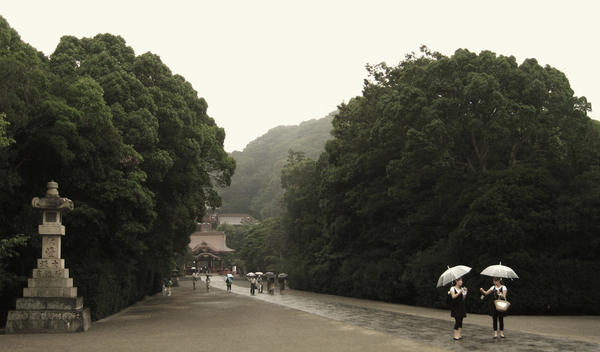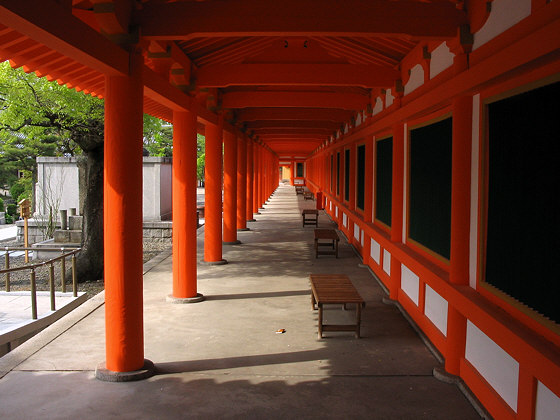Sunlight Through Tori
Where: Fushimi Inari-Taisha, Kyoto, Japan
When: Afternoon, July 24th, 2009
We visited Fushimi Inari Shrine's long tunnels of famous tori as the afternoon sun hung low in the sky and shone across the covered paths. I love this picture because the black and sunlit vermilion remind me of the wings of monarch butterflies.
Photo: Sunlight Through Tori (Japan 2009)
Tuesday, October 20, 2009
Posted by Vandrelyst at 6:48 PM 0 comments
Labels: Japan, Japan 2009, Photo
Photo: Rainy Day in Kamakura (Japan 2009)
Monday, October 19, 2009

Rainy Day in Kamakura
Where: Tsurugaoka Hachimangu Shrine, Kamakura, Japan
When: Morning, July 16th, 2009
It was raining - it was perfect.
Posted by Vandrelyst at 10:40 AM 0 comments
Labels: Japan, Japan 2009, Photo
Food: Koya Tofu (Japan)
Does freeze-dried Tofu sound appealing? How about intriguing, at least? If you're anywhere near Mt. Koya, you'll probably have the chance to taste this regional specialty. I personally tried it as part of the vegetarian dinner I ate while staying at Sanboin temple. It's interesting, to say the least.
While many foods can be described as spongy, Koya Tofu could easily be mistaken for an actual sponge. It absorbed an immense amount of liquid, has little flavour by itself, and the texture is exactly what you'd expect from a synthetic bath sponge. I was somewhat surprised it didn't taste soapy.
Picture: Some Googlesnatched Koya Dofu.
Posted by Vandrelyst at 10:25 AM 0 comments
Kyoto's Sanjusangendo
Friday, October 16, 2009
Even one of Sanjusangendo's statues of Kannon, the Buddhist goddess of mercy, is impressive. Each one stands life sized and is covered in gold leaf, has eleven faces, and twenty one sets of arms to symbolize the goddess's thousand. Can you picture one Kannon now? Good.
Now imagine 1001 of them, each one unique and hand carved from Japanese cypress, crowded into Japan's longest wooden building. A giant statue of the Thousand-armed Kannon sits in the middle of the hall, with 500 smaller (merely life sized) Kannons on each side. The youngest of the statues are almost 700 years old. The effect is mind blowing.

The temple's exterior, painted a striking vermilion, is worth a look as well.
Don't hurry off once you've seen the statues, or you'll miss the fascinating story of the other side of the hall, which has been used for the Tōshiya archery tournament since the 1600's. A small but fascinating display lists the truly awe inspiring records of Japan's best archers.
In the Oyakazu competition, for example, archers shoot as many arrows as they can within a 24 hour period, hoping to 'clear' - shoot the length of the hall without hitting the roof, floor, or pillars - as many arrows as possible.
In 1686, Wasa Daihachiro shot 13,053 arrows in Oyakazu, clearing 8,133 of them. This averages out to nearly 6 arrows a minute for twenty four hours straight.
Sanjusangendo is in Kyoto, Japan.
Posted by Vandrelyst at 9:18 AM 0 comments
Labels: Art, Japan, Japan 2009, Religion
Food: Tofu
Friday, October 9, 2009

Sadly, in America many people are afraid of Tofu. This may have to do with a strong association of Tofu with a vegetarian diet - the idea of a "Tofurkey" served for Thanksgiving sounds to many Americans like an unholy violation of their traditions. Still, I say sadly because Tofu can really be delicious.No one should try tofu only once and decide it's not for them, because it simply comes in so many different forms, with vastly different textures and methods of preparation. I will update this list of featured Tofu types and dishes as I write more about this versatile foodstuff.
Types of Tofu (or closely related products):
Yuba: "Tofu Skin" (Chewy)
Koya Tofu: Freeze Dried Tofu (Spongy)
Posted by Vandrelyst at 10:04 AM 0 comments
Food: Yuba (Japan)
Yuba, also known as soybean skim, is a Japanese food made from the skin that forms on the surface of boiling soy milk. The result is a bundle of thin, rubbery layers of a firm, tofu like substance. Yuba can be shaped in order to texturally resembled other foods, such as chicken breasts, and is often fried to give it a firmer skin. You can even deep fry yuba, like in this googlesnatched photo!
The first time I ordered a dish with yuba, I didn't know what it was. This is common in Japan and probably for the best. I would have missed out on many culinary adventures had I been afraid to eat some Japanese dishes based only on their not always appetizing English names! My first yuba experience was a clam chowder, and I almost mistook the yuba for incredibly tender clams. After this I took every opportunity to order yuba.
As with other Japanese Tofu dishes, my advice for yuba is to give it a try. Don't think about past experiences with soyburgers or tofurkey back home. Japan has many soy products in it's cuisine, and they vary widely by texture, taste, and application. You are not guaranteed to enjoy yuba, but it deserves to be given a chance.
Posted by Vandrelyst at 9:59 AM 0 comments


